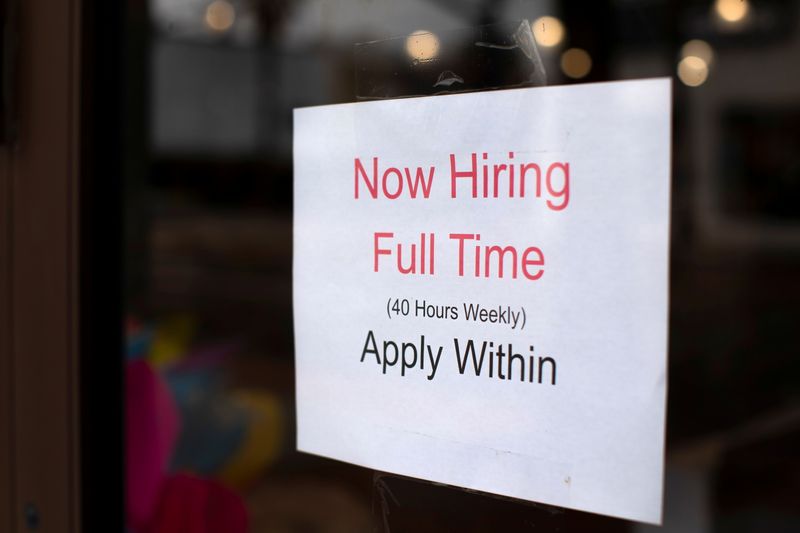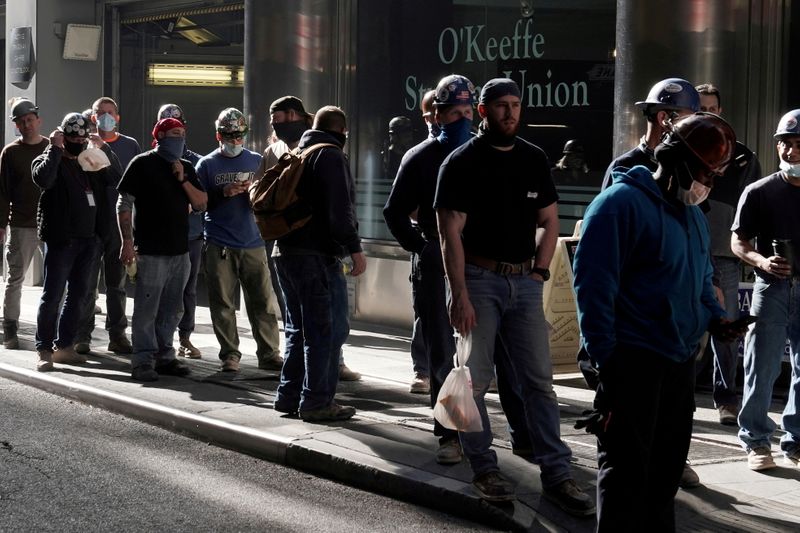By Lucia Mutikani
WASHINGTON (Reuters) - U.S. job openings surged to a record high in March, further evidence that a shortage of workers was hampering job growth, even as nearly 10 million Americans are looking for employment.
The Labor Department's monthly Job Openings and Labor Turnover Survey, or JOLTS report, on Tuesday also showed layoffs dropping to a record low in March. The report could put pressure on the White House to review government-funded unemployment benefits programs, including a $300 weekly supplement, which pay more than most minimum wage jobs.
The benefits were extended until early September as part of President Joe Biden's $1.9 trillion COVID-19 pandemic relief package approved in March. Alabama, Montana and South Carolina are ending government-funded pandemic unemployment benefits for residents next month. Those benefits cover the self-employed, gig workers and others who do not qualify for the regular state unemployment insurance programs.
"As more restrictions are lifted throughout the country, more businesses are opening up," said Sophia Koropeckyj, a senior economist at Moody's (NYSE:MCO) Analytics in West Chester, Pennsylvania. "However, there seems to be a mismatch between businesses' eagerness to return to some semblance of pre-pandemic normality and many workers' hesitation to step back into the workforce."
Job openings, a measure of labor demand, jumped 597,000 to 8.1 million on the last day of March, the highest since the series began in December 2000. The surge was led by the accommodation and food services sector, with 185,000 vacancies opening up. There were an additional 155,000 job openings in state and local government education.
In the arts, entertainment and recreation industry, vacancies increased by 81,000 jobs. Vacancies also increased in manufacturing, trade, transportation and utilities industries as well as in finance. Job openings rose in the Northeast and Midwest regions. But vacancies dropped in the healthcare and social assistance industry.
Economists polled by Reuters had forecast job openings would rise to 7.5 million in March. The job openings rate shot up to 5.3% from 5.0% in February.
Companies are scrambling for labor to meet pent-up demand that has been unleashed by the massive fiscal stimulus and rapidly improving public health. A separate report from the NFIB on Tuesday showed small businesses reported record-high vacancies in April. The openings were for both skilled and unskilled labor.
Stocks on Wall Street were trading lower. The dollar slipped against a basket of currencies. U.S. Treasury prices fell.
Graphic: JOLTS, https://graphics.reuters.com/USA-STOCKS/jbyvrykzgpe/jolts.png
LAYOFFS AT RECORD LOW
The disconnect between the high unemployment and worker shortages has also been blamed on fears of contracting the virus even though all adult Americans can now access the COVID-19 vaccine. Some parents are still at home caring for children as schools gradually return to in-person learning.
There have also been coronavirus-related retirements and others are making career changes because of the pandemic.
The government reported last Friday that nonfarm payrolls increased by only 266,000 jobs in April after rising 770,000 in March. Employment is 8.2 million jobs below its peak in February 2020 and 9.8 million people were recorded as officially unemployed in April.
Cleveland Federal Reserve Bank President Loretta Mester told Yahoo Finance on Tuesday that while it was "true that with the extension of the unemployment benefits people are in a financial position so that they can make those hard choices about whether they feel comfortable reentering or not," the benefits themselves are not causing the problem.
Mester said health concerns with vaccinations still nowhere near full uptake, difficulties accessing childcare and school closures were the key issues. Treasury Secretary Janet Yellen has also pushed back against criticism that unemployment checks were keeping people at home.
According to the JOLTS report, there were 1.2 unemployed people for every open job in March. That compares to 0.82 on the eve of the first wave of the pandemic lockdowns 13 months ago.
Graphic: Job openings to unemployed, https://graphics.reuters.com/USA-ECONOMY/JOLTS/azgpogkqxpd/chart.png
The JOLTS report showed hiring increased to 6 million in March from 5.8 million in the prior month. State and local government education hiring rose. There were also gains in educational services as well as mining and logging. The hiring rate climbed to 4.2% from 4.0% in February.
Economists expected the job openings and unemployment disconnection to resolve when the extended benefits lapse, companies raise wages and more Americans get vaccinated, though some worried raw material shortages could hold back hiring.
"Before long many more workers will come back into job-search as it becomes increasingly safe to pursue these public facing jobs ... and as wages rise to compensate for the extra risk of working in face-to-face places during the lingering pandemic," said Elise Gould, a senior economist at the Economic Policy Institute in Washington.
Graphic: Labor market index Labor market index, https://graphics.reuters.com/USA-ECONOMY/LABORINDEX/nmopaoxozpa/chart.png
Layoffs dropped to a record low 1.5 million in March from 1.7 million in the prior month. Layoffs decreased by 93,000 in construction, which has been buoyed by strong demand for housing. The layoffs rate dropped to 1.0% from 1.2% in February.

The number of people voluntarily quitting their jobs rose to 3.5 million from 3.4 million in February. The quits rate was unchanged at 2.4%.
The quits rate is normally viewed by policymakers and economists as a measure of job market confidence. But the pandemic has forced millions of women to drop out of the labor force mostly because of problems related to child care.
